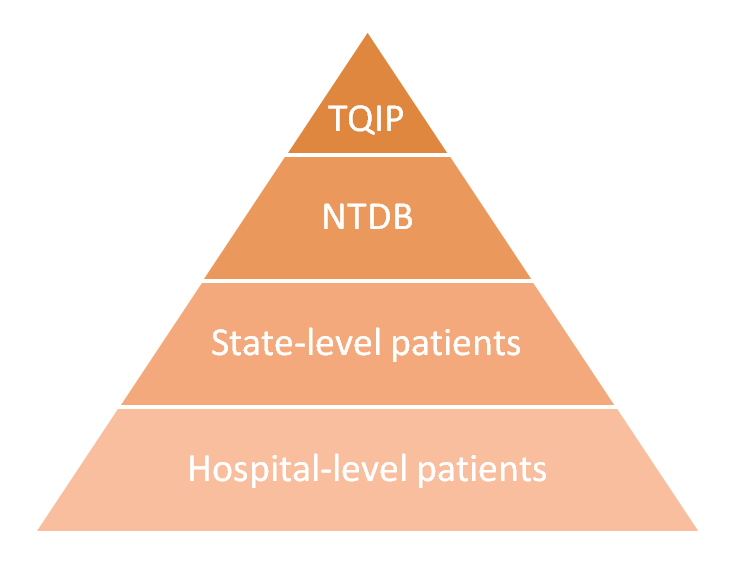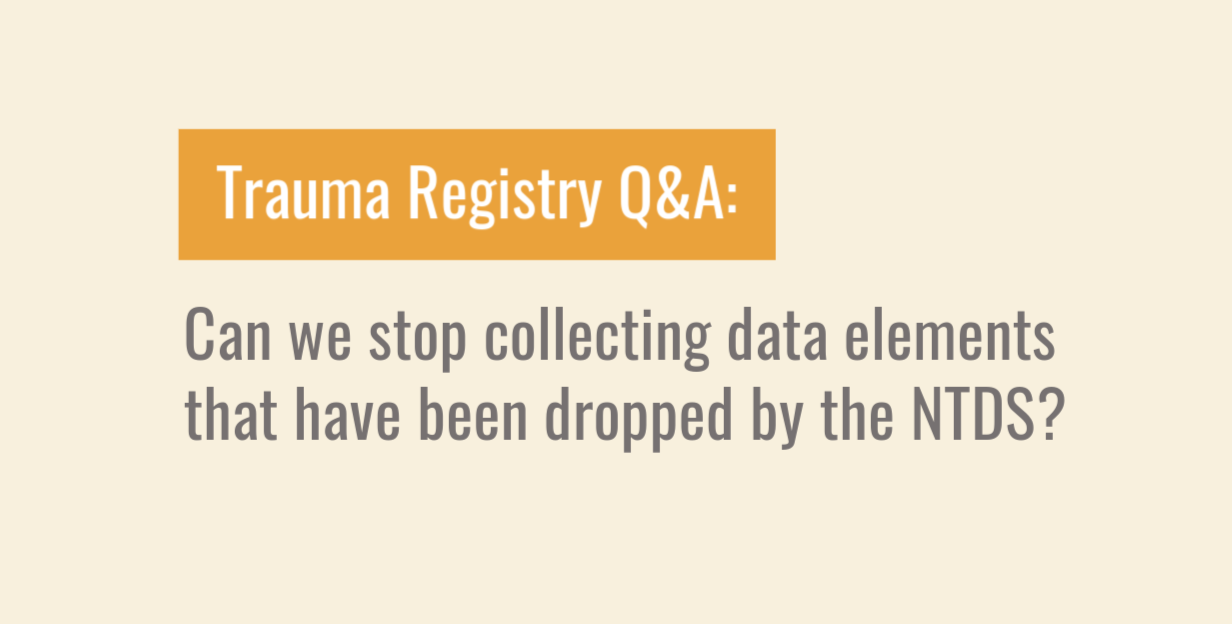The National Trauma Data Standard (NTDS) Data Dictionary for 2021 Admissions includes two significant changes. First, the patient inclusion criteria no longer include burn injuries. Second, the total number of EMS data fields has been reduced by more than three-quarters.
Many overworked trauma registrars have welcomed these changes with a sense of excitement. Fewer NTDS data requirements will mean less time abstracting each case, right?
Not necessarily. The reality is that the NTDS is not the final word on what should or should not be collected in a given hospital’s trauma registry. To understand why, let’s look at some specific questions.
Q. What does the ACS say about trauma registry inclusion criteria?
The American College of Surgeons (ACS) Committee on Trauma created the NTDS Data Dictionary to serve as a uniform set of trauma registry variables and associated definitions. These variables define the content of the National Trauma Data Bank (NTDB). Part of the NTDB vision is that all hospital trauma registries (regardless of designation status) capture the data specified in the NTDS.
However, the NTDS Data Dictionary does not limit the contents of local trauma registries. Here is one often missed statement from Resources for Optimal Care of the Injured Patient 2014:
“The exact inclusion and exclusion criteria used to select patients for entry into a trauma registry vary across hospitals. Some trauma centers, trauma systems, and state agencies modify the inclusion and exclusion criteria to address the specific needs of their patient populations.” [Chapter 15, p. 107, emphasis added]
The key point is that the purpose of a trauma registry is to help trauma program leaders serve the needs of their patients. Consequently, data collection should be guided first and foremost by the requirements of the trauma team’s internal programs.
Put another way, the goal of the NTDB is to inform the medical community, the public and decision makers about a wide variety of issues that characterize the current state of care for injured persons in the U.S. The primary goal of the hospital trauma registry is to assist in the operation of the trauma center.
Q. How should we determine our patient inclusion criteria?
In terms of patient inclusion and exclusion, the main question is not, What does NTDS require? The question to focus on is, What data do we need to serve our patient population, manage our programs and improve our care?

The next level of the triangle is any state or regional trauma registries that the hospital submits data to. Inclusion or exclusion criteria are based on the needs of the system.
The third level is the NTDB dataset as defined by the NTDS Data Dictionary.
The tip of the triangle consists of Trauma Quality Improvement Program (TQIP) patients, who must meet additional criteria above that of NTDS for inclusion. For example, TQIP patients must have an injury with an Abbreviated Injury Scale (AIS) of 3 or greater in at least one body region.
Q. How does this play out practically?
A good example is admission status. The NTDS Data Dictionary specifically excludes patients who were not admitted as an inpatient or for observation. However, there are different ways to look at this specific trauma patient population and many different views.
One level down in our triangle, some state/regional registries require hospitals to submit data on any patient who has had a trauma activation. Similarly, a trauma program might decide to capture data on any trauma activation patient, regardless of whether he or she was admitted beyond the emergency department. Some trauma centers include these patients in the registry for the purpose of monitoring their overtriage rates. Other centers find alternate methods for capturing this data.
The main point is that — aside from NTDS requirements — the decision whether to collect or not collect a certain data element depends on the needs and goals of the individual hospital and any other registry to which it submits data.
Over the years, the NTDB has made many changes to its data collection requirements. In the early days, you may have collected data on Drug or Alcohol Withdrawal Syndrome. This data element was retired in 2017, but your program might still decide to collect it for trauma PI or other program management needs. Another example is pneumonia. This “complication” was retired in 2016 and replaced with Ventilator-Associated Pneumonia (VAP), yet some trauma registries may still capture and track this data for internal PI purposes.
Remember, just because a data element is not captured by the NTDS, it does not necessarily mean the element does not need to be captured “locally.”
Q. So, do we still need to collect data on patients with burn injuries?
The answer is a solid “it depends.”
Under the 2021 NTDS Data Dictionary, burn data no longer needs to be submitted to the NTDB. However, these data elements may still be included into your institutional trauma registry if burn patients are part of your program.
In addition, consider the requirements of any other registries your program submits data to. This could be a state, regional or system registry. And if your hospital is verified by the American Burn Association (ABA), you need to collect this data and submit it to the ABA burn registry.
Q. But what about EMS data?
The 2020 edition of the NTDS Data Dictionary listed 23 distinct Pre-Hospital Information data elements. The 2021 edition lists only 5. Is this a “green light” for trauma registries to reduce the scope of their EMS data collection?
To answer that question, it is important to understand some of the background issues for this change.
EMS data required in the 2020 dictionary (and before) included a range of initial vital signs, which are important from a case review perspective. These and other data elements have been dropped from the 2021 dictionary and replaced with the EMS Patient Care Report Universally Unique Identifier (UUID).
The UUID is a number that is automatically generated when the EMS agency enters its data into the National EMS Information System (NEMSIS) database. The UUID will not be nationally available until the release of version 3.5.0, which is expected August 2021. Capturing the UUID as part of the NTDS will make it possible to link the NTDB and NEMSIS databases in the future. However, this is a huge step and it will take time. At the institutional level, linkage to NEMSIS may be even further down the line.
The bottom line: For the time being, trauma registries will still need to capture a full range of EMS data elements. Capturing this data locally remains essential to hospital-level review of EMS care and trauma PI efforts. Likewise, state or regional trauma registries may still require EMS data elements to be reported.
Q. If we still need to capture these data elements, how do we exclude them from our NTDB submission?
It depends on the capabilities and configuration of your trauma registry software. Some registry software systems include an “EXCLUDE from NTDB” checkbox. Simple click this box and the patient will not be included in your NTDB/TQIP submission XML file. In other software systems, you may need to create a filter to “EXCLUDE” certain patient groups (such as burns) before you run the submission file.
So the bad news is that fewer NTDS requirements will not likely lighten the workload for trauma registrars. The good news is that these changes give all trauma professionals a fresh opportunity to examine their data collection plan and make sure it is focused on the needs of the center’s patients and its PI program.
By focusing on data-driven performance improvement, we change the care we provide one patient at a time, one facility at a time, contributing to overall improvement in the trauma system.
Michelle Pomphrey, MLT, RN, CSTR is CEO of Pomphrey Consulting.
Make Sure Your Trauma Registry Team Is Up to Speed
Under the revised ACS trauma center requirements, registrars will need to take an ICD-10 course or an ICD-10 refresher course every 5 years. The brand-new Trauma Specific ICD-10 Refresher Course from Pomphrey Consulting provides a thorough review of ICD-10 coding organization and structure, explores recent coding updates and examines common trauma coding challenges. For full details on course content, dates and registration, visit Trauma Specific ICD-10 Refresher Course.

